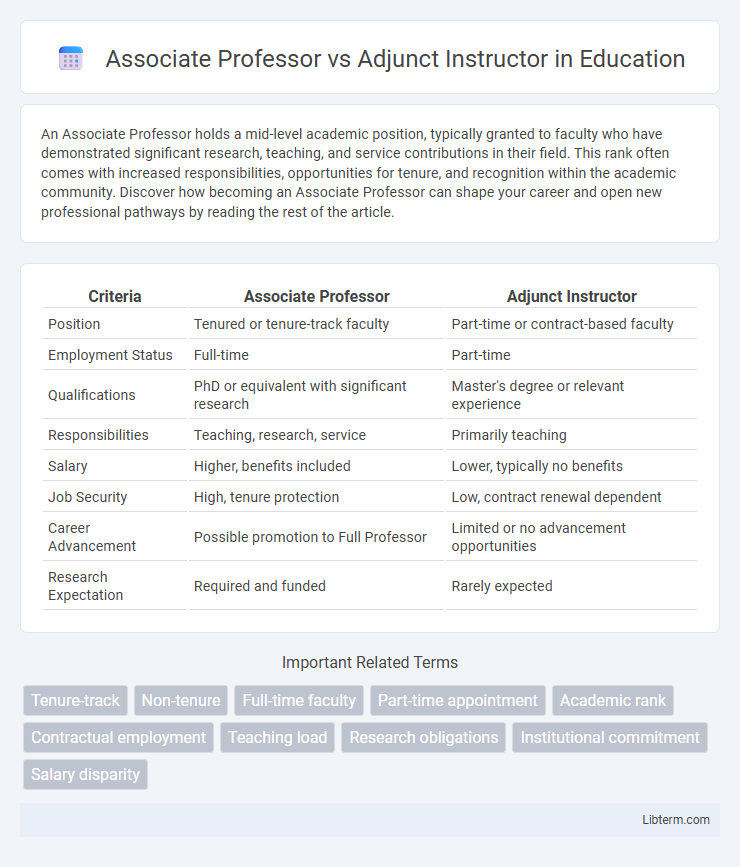An Associate Professor holds a mid-level academic position, typically granted to faculty who have demonstrated significant research, teaching, and service contributions in their field. This rank often comes with increased responsibilities, opportunities for tenure, and recognition within the academic community. Discover how becoming an Associate Professor can shape your career and open new professional pathways by reading the rest of the article.
Table of Comparison
| Criteria | Associate Professor | Adjunct Instructor |
|---|---|---|
| Position | Tenured or tenure-track faculty | Part-time or contract-based faculty |
| Employment Status | Full-time | Part-time |
| Qualifications | PhD or equivalent with significant research | Master's degree or relevant experience |
| Responsibilities | Teaching, research, service | Primarily teaching |
| Salary | Higher, benefits included | Lower, typically no benefits |
| Job Security | High, tenure protection | Low, contract renewal dependent |
| Career Advancement | Possible promotion to Full Professor | Limited or no advancement opportunities |
| Research Expectation | Required and funded | Rarely expected |
Understanding Academic Titles: Associate Professor vs Adjunct Instructor
An Associate Professor is a tenure-track or tenured faculty member who typically holds a doctoral degree and has demonstrated significant teaching, research, and service contributions within a university. An Adjunct Instructor is a part-time or contract-based faculty member often hired to teach specific courses without tenure or the same research responsibilities. Understanding academic titles helps clarify the differences in job security, faculty responsibilities, and institutional roles between these positions.
Definition and Core Responsibilities
An Associate Professor is a tenured or tenure-track faculty member involved in teaching, research, and service within a college or university, typically holding a higher academic rank than an Adjunct Instructor. Core responsibilities include developing curricula, publishing scholarly work, advising students, and participating in departmental governance. An Adjunct Instructor primarily focuses on teaching specific courses on a contractual basis, often without obligations for research or institutional service.
Hiring Process and Qualifications
The hiring process for an Associate Professor typically involves a rigorous evaluation of academic credentials, research publications, and teaching experience, often requiring a doctoral degree and a strong record of peer-reviewed scholarship. In contrast, an Adjunct Instructor is usually hired based on subject matter expertise and professional experience, with a focus on teaching skills rather than research output. Qualifications for Associate Professors demand extensive academic achievements and tenure-track eligibility, whereas Adjunct Instructors may hold a master's degree or relevant professional background without tenure considerations.
Employment Status: Full-Time vs Part-Time
Associate Professors hold full-time, tenure-track or tenured positions with responsibilities in teaching, research, and service, reflecting long-term institutional commitment. Adjunct Instructors are typically employed part-time on contract basis, focusing mainly on teaching with limited or no research obligations and without tenure eligibility. The distinction in employment status directly impacts job security, benefits, and academic influence within the institution.
Research and Publication Expectations
Associate Professors are typically expected to maintain an active research agenda, regularly publishing peer-reviewed articles, securing grants, and contributing to the advancement of their academic field. Adjunct Instructors usually have limited or no research obligations, focusing primarily on teaching responsibilities with minimal expectations for publications. The difference in research and publication expectations significantly impacts career progression, with Associate Professors evaluated heavily on scholarly output for tenure and promotion.
Teaching Load and Course Assignments
Associate Professors typically have a more balanced teaching load combined with research and administrative responsibilities, often teaching multiple courses per semester. Adjunct Instructors usually handle a heavier teaching load focused solely on instruction, frequently assigned to teach one or two courses without research or service obligations. Course assignments for Associate Professors often include advanced or specialized classes, while Adjunct Instructors generally teach entry-level or high-demand courses based on departmental needs.
Compensation and Benefits Comparison
Associate Professors typically receive higher compensation than Adjunct Instructors due to their permanent, tenure-track status and greater academic responsibilities. Benefits for Associate Professors often include health insurance, retirement plans, paid sabbaticals, and research funding, while Adjunct Instructors usually have limited or no access to these benefits. Adjuncts are commonly paid per course with lower hourly rates and lack job security, highlighting significant disparities in both salary and benefits.
Career Advancement Opportunities
Associate Professors typically hold tenure-track positions with clearer pathways to tenure and promotion, enhancing long-term career advancement and job security. Adjunct Instructors often engage in part-time or contract-based roles with limited access to institutional resources, professional development, and formal promotion tracks. Career advancement for adjuncts is generally constrained by the lack of tenure prospects and reduced institutional support compared to Associate Professors.
Job Security and Contract Length
Associate Professors typically hold tenure-track positions offering higher job security and contracts lasting multiple years or indefinite terms. Adjunct Instructors work on short-term, often semester-by-semester contracts with limited job security and no guarantee of renewal. This disparity impacts career stability and long-term academic planning within higher education institutions.
Influence on Campus and Administrative Roles
Associate Professors hold significant influence on campus through participation in faculty governance, curriculum development, and departmental decision-making, reflecting their permanent, tenure-track status. Adjunct Instructors typically have limited administrative roles and exert less influence, as they often engage solely in teaching responsibilities without involvement in long-term institutional planning. The distinction in campus impact stems from the differences in employment terms, institutional commitment, and faculty rank within university hierarchies.
Associate Professor Infographic

 libterm.com
libterm.com